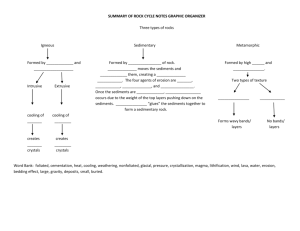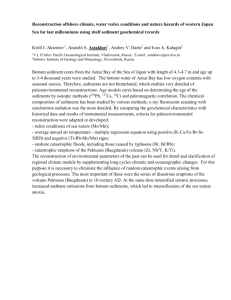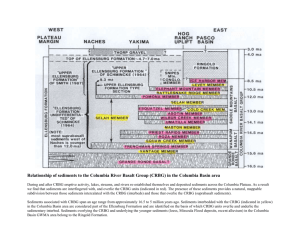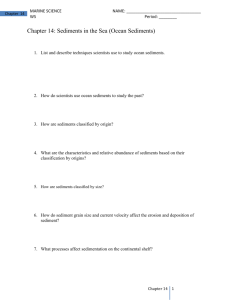• ,. EFFECTS OF ENVIRONMENTAL CONTAMINANTS ON THE MALE GAMETE OF Al\IERICAN PLAICE;
advertisement
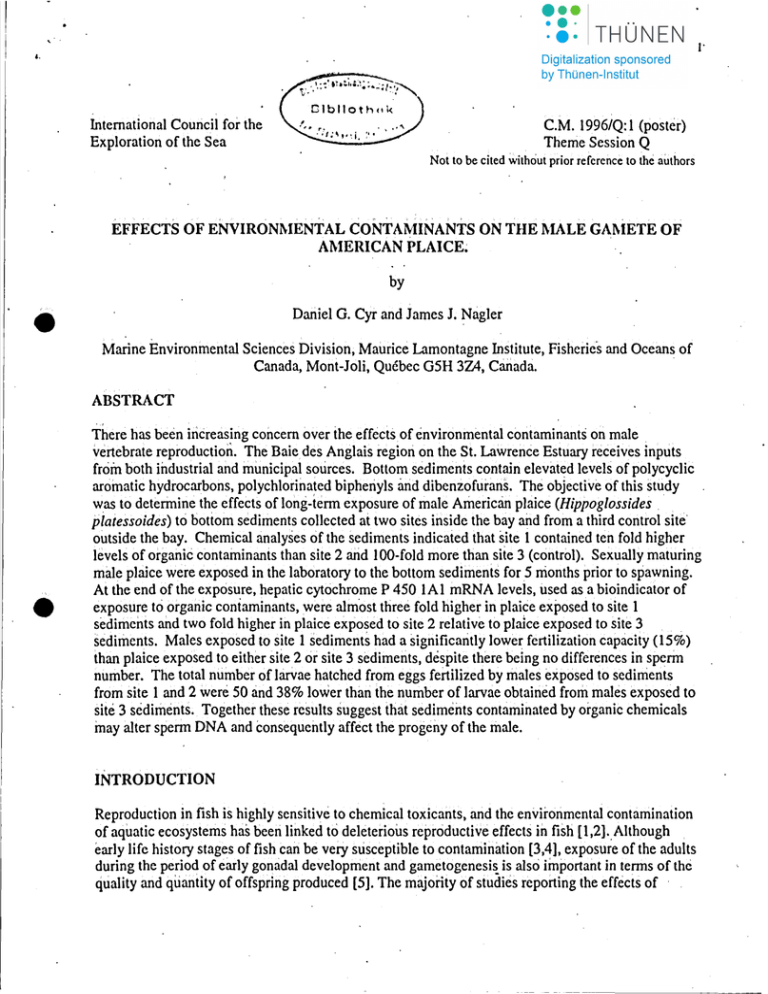
,.
"
I'
International Council for the
Exploration of the Sea
C.M. 1996/Q: 1 (poster)
Theme Session Q
Not to be cited without prior refcrcnce to the authors
.
.
EFFECTS OF ENVIRONMENTAL CONTAMINANTS ON THE MALE GAMETE OF
Al\IERICAN PLAICE;
by
•
Daniel G. Cyr and James J. Nagler
Marine Environmental Sciences Division, Maurice Lamontagne Institute, Fisherie's and Oceans of
Canada, Mont-Joli, Quebec G5H 3Z4, Canada.
ABSTRACT
•
There has been increasing concern over the effectsof environmental contarninants on male,
vertebrate reproduction. The Haie, des Anglais region on the SI. Lawrence Estuary receives inputs
froin both industrial and municipal sources. Bottom sediments contain elevated levels of polycyc1ic
aromatic hydrocarbons, polychlorinated biphenyls und dibenzofurans. The objective of this study
was to determine the effects of long-term exposure of male American plaice (Hippoglossides ,
platessoides) to bottom sediments collected at two sites inside the bay arid from a third control site'
outside the bay. Chemical analyses of the sediments indicated that site I contained ten fold higher
levels of organic contaminants than site 2 arid lOO-fold more than site 3 (control). Sexually maturing
male plaice were exposed in the laboratory to the bottom sediments for 5 months prior to spawning.
At the end of the exposure, hepatic cytochrome P 450 lAI mRNA levels, used as a bioindicator of
exposure to organic contaminants, were alm'ost three fold higher in plaice exposed to site I
sediments and two fold higher in plaice exposed to site 2 relative to plaice exposed to site 3
sediments. Males exposed to site I sediments had a significantly lower fertilization capacity (15%)
than plaice exposed to either site 2 or site 3 sediments, despite there being no differences in sperm
number. The total number of larvae hatched from eggs fertilized by males exposed to sediments
from site 1 and 2 were 50 and 38% lower than the number of larvae obtained from males exposed to
site 3 sediments. Together these results suggest that sediments contaminated by organic chemicals
may alter sperm DNA and consequently affect the progeny of the male.
INTRODUCTION
Reproduction in fish is highly sensitive to chernical toxicants, and the environmental contamination
of aquatic ecosystems has beeri linked to deleterious reproductive effects in fish [1,2].. Although
early life history stages of fish can be very susceptible to contamination [3,4], exposure of the adults
during the period of early gonadal development and gametogenesi~ is also important in terms of the
quality and quantity of offspring produced [5]. The majority of studies reporting the effects of
2 •
contaminant exposure on gametogenesis irivolve the female [6-8]. The effects of contaminant
exposure on males prior to spawning and the possible influence this could have on the quality of
sperm and resulting larvae, exclusive of matemal influence, has received liule attention.
'.
Amongst fish species that inhabit contaminated marine environments, those living on or near the
bouom are most at risk. This is due to the bulk of contarninants in marine habitats being associatcd
with the bouom sediments. Flatfish are often studied because of their benthic lifestyle and econorruc
importance iri commercial fisheries. Some studies have documented biochemical and physiologic3.l
alterations in flatfish living in contaminated areas [9-11], but it is difficult to interpret these changes
in tenns of eventual reproductive output. Reproduction is best assessed by the quantity and quality
of offspring generated, since these features will have the greatest impact on future fish popuiations.
Far fewer reports exist conceming the reproductive output of fhltfish living in contaminated habitats
[12,13].
.
The present study was undertaken to detennine whether chronic exposure to environmentally
contaminated sediments, during the period leading ur to spawning, would impair the reproductive
perfonnance of male American plaice. This was assessed primarly by fertilization and hatching
success of eggs, from a single non-exposed female, that were fertilized with sperm from males
exposed to sediments containing different degrees of organic contamination. Sediments were
obtained from three sites on a marine estuary (Haie des Anglais, Quebec) that have been previously
characterized in terms of their toxicity and contaminant levels [14]. The level of liver cytochrome
P450 lAI mRNA was used as a biomarker to indic:iie exposure to orgariic compounds [15].
•
MATERIALS AND :METHODS
Animals
American plaice (Hippoglossoides platessoides) were captured by trawl on the St. Lawrence Estuciry
near Matane, Quebec, approximately severi months before exposure. The fish were maintained in
holding facilities as previously described [14]. Fish were fed chopped capelin twice weekly and
every sixth feeding fed in-house prepared capelin-based food pellets supplemented with vitamins
.
. [16].
EXpeTimental Protocol
in
Fig. I. Map showinglocations (Sites 1,2 alld 3)
and near Baie des Anglais. Qutbec, C8nada from
which the sediments were collected. The let;ers denote
the location ofthe grain storage facility (A), aluminum
smelter (8), pulp and paper mill (C) and munidpal
sewage outfall (0).
Three sites (designated Sites 1,2 and 3) in and near
Haie des Anglais, Quebec, previously characterized
for geographicallocaiion, and sediment chemical
concentrations and toxicity were used [14]. These
sites represent a contamination gradient with Site I
the most contaminated, Site 2 about lO-fold less so,
and Site 3 IOD-fold less contarninated (Le. control).
The sediments from these sites contain,
predominantly, organie compounds such as
polycyclic aromatic hydrocarbons (PAlIs),
polychlorinaied biphenyls (peBs), and
•
-
• ~J,'t'''''~:-'''-.~\~.(
-
l
i·-t
,!",~.,
.,.~,.~
,
.....
-------
-----
3
dioenz()fu~ans (PCDFs). Metai levels are ,low and represeritriiive ofbackgroimd levels founcl
throughout the St. Lawrence River andEstuafy [14].
•
,\','
~.'" .... r
>
.'
T-
' ; . ' : , , .. ~
0.
=. . .
'.'(~
.
.
,
Mature male plaice were exposed for rive months, prior to spawning, to sediments collected rit the
three sites in 0.9 x 1.2 x 0.6 m tanks containirig 15 cm of premixed sediments. ,At the end of the
exposure period semen was collecied from all fish with motilc sperin and use~ to fertilizc eggs ;
(250) from a non-exposed female. Fertilized eggs wcre mairitained until hatchirig. One week after
spawningthe anesthetized males were killed, weighed, and measured. Their livers were removed,
froien in liquid nitrogen~ and stored at ·80°C. The iuimber of sperm per ml semen was detennined
by appropriatelydiluting thesemeri and counting the sperm with a hemocytometer. A subs~ple of
se.{!1en was.separate,d fr~m the sp~~ by centiifugation, ari~ the coricen~ration~f~emi~~ N,a and
K determmed by atomlC absorptIOn spectrophotometry usmg appropnate Na and K standards.
Th~ number of feriiiized eggs (FE) was determined, 24 hr after fertilization, by couriting the number
of floating and hydrated eggs in orie jar from each male. Plaice eggs tipon successful fertilization
tiridergo dramatic hydratiori and are buoyant [17], allowing easy separation of fertilized and nonfertilized eggs. The total number of eggs (TE) was determined by summing the FE and the nonfertilized eggs, and percent fertilization calculated as (FElTE)x 100. Thc remaining two jars of ,
feriilized eggs were maintained until the larvae hatched, between 16-18 days post-fei1ilization. Each
day all dead eggs were removed from the jars and 75% of the seawater was replaced. ,The numbcr of
larvae that hatched each day were recorded arid removed from the jar; a mean was calculated from
the total number hatched from each of the two jars for each male. The total hatch (TH) waS
calculated as the mean rtumber of laivae for all rriales withiri a given treatment.
•
,.0:""
Northem blot analysis was done ori total celluiar RNA was isolaied from'liver using a fuIl length
cDNA probe from European plaice (Pleuronecles plaleSSa)Cytochrome P450 lAI (CYP lAI) [18],
which was generously provided oy Dr. S.O. Oeorge (NERC,University of Stirlirig, Stirling,
Scotland).Quantification ofthe intensity ofthe CYPIAI mRNA sigrial from each sampIe waS
ineasured by densitometry and corrected foi' sampIe loading using the intensity of the 18S rRNA
signal [14].
. Ai! data are presented as the meari ± thc'standard error of the meari. Percent fertilization values were
Me sinc transforrried hefore statisiical tests were applied. The data for each parameter sttidied were
compared by ANOVA (p<O.05) to determine if significant differences existed. A iimltiple
eompanseins test (Tukey's Test) was used to identify significant differences (1'<0.05) between
treatment groups.
RESULTS AND DISCUSSION
The exposure of maIe plaice tei botteirri sediments contaminaterl with organic ceimpourids, prior to
the spawriing season, and subsequeritly using their sperrn to fertilize "clean" eggs has been shown io
significaritly reduce the number of larvae that hatch (Fig. 2). Most studies in the past, which have
examiried the effect of pollutarit exposure on sexually developing fish, involve exposure of both
sexes. This approach makes it difficuIt to ascnbe any anomalies observed in. the resulting progeny to
orie sex or the other. Oenerally, it has becn presumed that the female is thc most pollution sensitive
of the two sexes, with respect to the probability of affecÜng the riumber or quality of thc offspring
4
A
B
•
•
produced. There is good reason to accept this presump.tion
and it derives from two features of oviparous fish
reproductive physiology; 1) the much greater energetic
investment required to produce eggs versus sperm. and 2)
the opportunity for transfer of matemally bioaccumulated
toxins to thc yolk of developing oocytes and eventual eggs.
A significant body of evidence exists to support the
detrimental effects of exposure of female.fish to toxic
.
chemicals during oogenesis and the resulting impact on the
offspring [20-23]. Previous studies in fish. in which the
effect of parental exposure on early life history stages were
dealt with in a way that separated effects arising from each
sex. indicated that males exposed to copper [24] or mercury
[25] had either no negative effect or significantly reduced
hatch. respectively. This study shows. for the first time. thai
exposure ofniale fish to organie contarninantsbefore
spawning can specifically affect the number of offspring .
produced.
.
The significant reductiori in the number of larvae hatched
from eggs fertilized by males exposed to the most .
contaminated sediments indicates a problem with the
quality of the sperm. since sperm numbers and other
o
quantitative reproductive parameters measured were not
a'Wa
significantly different between any treatment group (Table
1). The quality of sperm can be broadly assessed by the
Fig. 2. A. Percent (ertilization by sperm from male
of the sperm. speim-egg recognition. and
motility
American plaice exposed (or five months to
successful
transfer of the haploid complement of sperm
contaminatedsediments (rom three different sites. B
Mean number o( larvae hatched from eggs fertilized DNA to the egg. All these features of sperm quality. if they
by sperm from maleAmerican plaice exposed to .
are significantly impaired. are most easily detected by a
contaminated sediments from three different sites.
reduction in the mimber of eggs fertilized. Fertilization
•=significantly different from Sile 3 (p<Q.Ol).
success was marginally. but significantly.lower in fish
exposed to the most contarninated sediments (Le. Site 1). relative to the othertreatment groups. This
suggests that the process of fertilization could have contributed to the reduced hatch observed in
eggs fertilized by males exposed to Site 1 sediments. However. the capacity for fertilization in Site
1 exposed males was reduced by about 14%. compared to that of the Site 3 exposed group (Fig. 2).
while TH was reduced by 50% between these two treatments (Fig. 2). Therefore. the reduction in
percent fertilization of Site I exposed males can not account for the ultimate reduction in TH
observed in this treatment (Fig. 2). In addition. there were no differences in fertilization success
between males exposed to Site 2 and Site 3 sediments (Fig. 2). yet TH was significantly reduced oy
38% in the Site 2 exposed group. relative to the Site 3 exposed group. Tbe significant reductions in
TH which occurred in eggs fertilized by males exposed to contaminated sediments from Site 1 and
Site 2 probably results from a problem after fertilization was assessed (i.e. early embryological
development; >24 hours).
•
. . L . - - . L - - '_ _
Tbe mechanisni by which contaminants in the sediments from Sites 1 and 2 alter the sperm and
•
.~_. <
, l' .• '
. . . . . - . .. . \>
r··,,,,,,,,,,,,~"1
.
Table I. Reproductive parameIers from male Amcrican plaice exposcd for five monlhs 10 conlaminated sediments from
three different sites.
.
Site
2
Parameter
Sperm numbCr'
(x 10',ffiJ)
t
. ; ' . ' '., <
~.06 .,. i3 •:...,.. \.4.42.'. 1.7
\ ~
.
t
,..
.
•
3
3.71 .'·2.4
,
Seminal plasma sOdium (JJ&!ml)'
Seminal plasma potasslum (JJg/m1)
OSI
n
•
3100 .,. 556
136.;.20
2856.'·526
263.'· 141
1.51.'·0.4
0.98.'·0.4
6
4
5
4080
+,. 367.
150.'·54
1.70
+,. 0.26
7
cause th6 resulting dec~ease in hatched larvae is unknown. While it is pass'ible thai containinants
adduct to proteins on the spenn and äre transpoi1ed into th6 egg, the most likely explanatiori is an
alteration of the spenn DNA. Chemically induced DNA alterations in fish ean take the fonn of
adduction' arid secondarY modifications, such as strand breaks, chimges iri minor nucleoside .
compositiori and unscheduled DNA synthesis [26]. A flatfish, English sole (Paropllrysvetullls),
exposed to contaminated sediments exPedenced measurable levels of liver DNÄ adduction with
compotirids such as PAHs r271. Similarly, male Eriglish sole fed benzo(a)pyrene (BP) had BP
I
A
metabolitesadducted to testicular DNA [28]. The level of
•
PAlI combustion products faund in sediments from Sile
4
1 was 39.8pglg dry sediment [14], comparable to.
sediment PAH levels iri studies which repori English sole
liver DNA-PAH adduction [27]. It is possible that sPenn
DNA could become adducted following exposure to
these levels of sediment assOciated PAlIs, sirnilar to liver
DNA; Sediments from Site 1 also cantain high levels of
PCBs and PCDFs. Thc effect of these compounds on
DNA adduction or secoridarY modifications in fish is
unknown. Iri mammals, several DNA alkylating'
,. .
chemieals such as cyclophosphamide,
. 1,25
triethyleriemelarnine [291, methyl methanesulfonate [301,
B
. arid acrylamide [31] have been shown to alter spe~m .
•
1,00
. . DNA; Siüdies iri which cyclophosphamide was
.
adrninisten~d to male rats caused subsequerit post- ,
.
implantation 105s [321. This may be the result of a'
decrease in spermatozoal decondensatiori which occurs
following fertilization. Further' studies will be need6d in
order to determine if ä similar mechanism exists in plaice
exposed
to sediments containing organic contarninants.
MI
,
•
0.00 -'---,---,L.Itt. t
1"- a
Chionic exposure of male plake to sediments "
contaminated wiih organic compounds resulted in .
Fig. 3. A. Northem blot analysis ofhepatic CYPIAI
elevaied levels ofhepaiic CYPlAl mRNA (Fig.).,This
mRNA levels in male American plaice exposed for
is the conventionaI response of fish cyiochrome P450
live months to contaminated sediments from three
different sites B. Northem blot analysis ofhepatic
. erizym~~ ofthe lAI subfamily to organics, which are
CYPIAI mRNA levels in juvenile American plaice ,
exposed for two weeks to Site I arid Sile 3 sediments
The amount ofCYPIAI mRNA is expressed as arbitrary
units; • = significantly different from Site 3 (p<O.05).
6
...
finding wide usage as sensitive biomarkers of exposure to PAHs, PCBs, and PCDDs [15,33-35]. .Considering that the sediments from Sites 1 änd 2 have beeri shown to contain higher conceritratioris
oforganic contaminants, relative to Site 3 [14], it is not surprising that hepatic CYPIAI mRNA
levels increased in plaice following exposure to these sediments. At the end of the exposure of
mature male plaice, immature plaice were exposed to sediments for two wecks. Similri.rly~
significaritly elevated levels ofhepatic CYPIAI mRNA were observed in juvenile plaice exposed to
sediments from Site 1 (Fig. 3), relative to Site 3.
In conc1usion, the sperm quality of male American phiice exposed to sediments col1<:~cted from an
environmentally contaminated location is severely impaired, resulting in a 50% reduction in the
number oflarvae hatched, relative to a control group. This is the first report that exposure of
maturing male fish to organic contamiriants, prior to spawriirig, can significantly affect the number~'
of resulting offsprlng; exc1usive of any fernalederived effects. The major effeet of redueed sperm ,
•
quality appears to be manifest dudng early embryologieal development (Le. >24 hC), arid rriay result .
from DNA alterations. Tbe impairment in speini quality docürriented is attributed to organie
compounds (PAHs, PCBs, arid PCDFs) whieh are known to be present at high levels in the
sediments and bioavailable to the fish aS indicated by elevated CYPIAi mRNA levels. The
..
treatment groupwith the highest level of CYPIAI mRNA induetion displayed the greatest deerease
in the number of embryos which hatched. This study was supported by the St. Lawerence Vision
2000 and Fisheries and Oceans Ctinada Toxie Cht!11.zicals Program.
REFERENCES
1. Spies, R.ß., J.J. Stegemari, D.\V. Rice, Jr., B. \Voodin, P. Thomas, J. E. Hose, J.N. Cross
and'l\I.Prieto. 1990. Sublethal reps'onses of Platiehthys stellatlls to organic contamination in San
Franciseo Bay with emphasis on reproduetion. Iri J.F. MeCarthy arid L.R. Shugart, eds., .
Biornarkers ofEnvironm~ntal Contaminaiion. Lewis Publishers, Chelsea, MI, pp. 87-122.
2. l\-lcl\laSter, M.E., G,J. Van Der Krank, C.B. Portt, K.R.l\lunkiUrick, P.K. Siblcy, I.R.
Smith and D.G. Dixon. 1991. Changes in hepatic mixed-funetion oxygenase (MFO) aetivity,
plasma steroid levels arid age at maturity of a white sucker (Catostomus commersonl) population
exposed to bleaehed kraft mill effluent. Aquat. Toxicol. 21: 199-218.
3. Kocan, R.M., H. von 'Vesternhagen, M.L. Landolt and G. Furstenberg. 1987. Toxicityof .
sea-surface mierolayer: effects of hexane extraet
Baltic herring (Clupea harengus) andAtlaniic
eod (Gadus morhua) embryos. Mar. Environ. ReS. 23:291-305.
on
4. \Veis, J.S. and P. 'Veis. 1989. Effeets of environmental pollutants on early fish developmenl
Rev.Aquat. Sei. 1:45-73.
5. ßenson, 'V.H., T. Dillon and ß. Suedel. 1994. Evaluation of reproductive effects of
anthropogenicchemicals in fish. Proceedings 3rd Biennial Inter. Symp. on Fish physiology,
toxicology and water qualiiy management. Nanjing, PRC, Nov. 3-5, 1992. pp. 14-20.
6. Niimi, A.J. 1983. Biological and toxicological effects of environmental contamimints in fish arid
their eggs. Can. J. Fish. Aquai. Sei. 40:306-312.
•
._:
_
. .~ • •'
.
• • _.'
__ r
__ •
1
7. Nagier, J.J., P. Aysola ari~ S.1\'I. ~ubY. 1986: Th~}~ffeci of subletllal pentachiorophenol
.
exposure ori .earlYoogenesis in maturing female rairibow trout (Salmo gairdlieri). Arch. Environ.
Cont. Toxicol. 15:379-385.
.
8. ThoiuaS, P. 1989. Effects of Aioc1or 1254 and cadmium on n~productive eridocrine fundion arid
ovarian growth in Atlantic croaker. Mar. Environ. Res. 28:499-503.
9. Spies, R.ri., D.\V. Rice, Jr., P.A. ~lont3gmi arid R.R. Irelrind. i985. Reproductive success,
xenobiotic contaminants arid hepatic rriixed-functionoxidase (MFO) activity in Platichthys
stellatus populations from Sari Frrincisco Bay. Ma'. Environ. Res. 17: 117-121. .
10. Johnson, L.L, E. Casillas, T.K~ Collier, n.n.l\1cCaln arid U. Varanasi: 1988. Co~taminant
effects on ovarhin development in English sole (Paroplzrys vetlilus) from Puget Sound,
Washington. Can. J. Fish. Aqlwt. Sei. 45:2133-2146.
'
11. Loizeau, V. and A. Abarnou. 1994. Distribution of polychlorinated biphenyls' in dab (Limanda
limanda) from the Baie de Seine (Easlern Chaimel). Mar. Environ. Res. 38:77-91. .
t2. Spies, R.B. arid 1\1.\V. Rice, J r. i 988. Effects of organic contaminantson reproduction of the
starry flounder (Platichtlzys steIlaius) in San Fraricisco BaY. Mar. Riol. 98: 191-200.
.
L.n.
13. Casillas, E., D. ~lisitario, L.L. johnson,
Rhodes, T.K~ Coiiier, J.E. Steiri, B.B. ~lcCain
rind U. Varanasi. 1991. Inducibility of spawning arid reproductive success of female English
sole (Paroplzrys vetuills) from urban arid nonurban areas of Puget Sound, Washington. Ma,..
Environ. Res. 31:99-122.
•
«"'.
14. Nagler,Jj~, A. Lacroix; M~ Fourriier, 1\1. Lebeuf, K. Lee rind n.G. Cyr.1996.
Toxicological characteriiation of marine sediments from Baie des Anglais on the
S1. Lawrence Estuafy. Environ. Toxicol. Chern. (submitted)..
15. Stegemari, j., 1\f.Uroull'er, R.T. Dl Ghdio, L FÖrÜri, ß~A; Fowler"ß.~1. Sander~ rind P. A~
Van Veld. 1992. Moleculrir responses to erivironmental contamination: enzyriie aridprotein
systems :lS indicators of chemical exposure and effec1. Iri RJ. Huggeü, R.A; Kirrierte, P.M.
Mehrte, Jr., and H.L. Bergman, eds., Biomarkers: biological, physiological; arid histologiCal
. markers of Anthropogenie stress. Lewis P.ublishers, Boca Raton; FL; pp. 235-335. . .
i6. Pro\'cncher,
P. ßryl;
Gcndron, Roy a~d J. Boyer. i995. Essais d'aliinentation de la
morue fränche (GeidilS 11zor/llIa). Rapp. can. ind. sei. halielit. aquat. 228.
L,
A.
F.
1'7. Lonning, S. and j. Dannport. 1980. Tlle swelling egg oftlle long rough dab, Hippoglossoides
platessoides limaridoides (Bloch). J. Fish Riol. 17:359-378.
.
.
18.CYr, D.G.,'L. ilcrmo, O.\V. ßlaschuck,'and ß.Robalre. 19~h.Disiributionarid regulation of
epithelial-cadheriri messenger iibonucleic acid and immurioeYt~~hemieaI localization of
epithelial cadherin in the rat epididymis. Endocrinology 130, 353-363.
.
8
19. Leaver, 1\1.J., L. Pirrit, S.G. George. 1993. Cytochrome P450 lAI cDNA from plaice
(Pleuronectes platessa) and induction of P450 lAI mRNA in various ,tissues by 3
-methylcholanthrene and isosafrole. Mol. Mar. Riol. Riotechnol. 2:338-345.
,V.
20. von 'Yesternhagen, H., H. RosenthaI, V. Dethlefsen,
Ernst, U. Harms ami P.-ti.
Hanson.1981. Bioaccumulating substances and reproductive success in Baltic flounder,
Platichthysflesus. Aquat. Toxicol. 1:85-99.
21. Geisy, J.P., J. Ne,,'sted and D.L. Garling. 1986. RelaÜonships between chlorinated
hydrocarbon conceritrations and rearing mortality of chinook salmon (Oncorhynchus
tshawytscha) eggs from Lake Michigan. J. Great Lakes Res. 12:82-88.
22. Black; D.E., D.K. Phelps arid R.L. Lapan. 1988. The effects of inhefited contaminatiori on egg
and larval winter flounder, Pseudopleuronectes americanus. Mar. Environ. Res. 25:45-62
23. 'Yalker, 1\1. K., P.M. Cook; A~R. Batterman, D.B. Lothenbach, C. Berini, J. Llbal, L
lIufnaglc and R.E. Peterson. 1994. Early life stage mortality, associated with maiemal transfer
of2,3,7,8-tetrachlorodibenzo-p-dioxin to lake trout oocytes. Can. J. Füh. Aquat. Sei. 51: 1410
-1419.
,
.
,
24. 1\funkittrick, K.R. and D.G. Dixon. 1988. Evidence for a matemal yolk factor associated with
increased tolerance and resistance of feral white sucker (Catostomas commersoni) to waterbome
copper. Ecotox. Environ. Saf. 15:7-20.
'V.
25. Birge,
J., J.A. Black, A.G. 'Ycstcrman and J.E. IIudson. 1979. The effects of mercury on
reproduction of fish and arnphibians. In J. Nriagu, ed., The Biogeochernistry of Mercury in the
Environment. ElsevierlNorth Holland, Amsterdam pp. 629-655.
'V.
26. Shugart, L., J. Bickham, G. Jacklm, G.1\Ic1\lahon,
R1dley, J. Steht and S. Steinert.
1994. DNA alterations. In: Biomarkers: ,biologieal, physiological, and histological markers.
27. Varanasi, V., J.E. Stein, W.L. Reichert, K.L. Tilbury; M.M. Krahri and S.-L. Chan. 1992.
Chlorinated and aromatic hydrocarbons in bottom sediments, fish and marine manimals in US
cOaStal waters: Laboratofy and field studies of metabolism arid accumulation. In C.H. Walker .
and D.R. Livingstone, eds., Persistent pollutants in marine ecosYstems. Pergarnon Press, Oxford,
U.K, pp. ~3-118.
28. Varanasi, V., 1\1. Nishirrioto, 'Y.L. Reichert and J.E. Stein. 1982. Metabolism and sübsequent
covalent binding of benzo[a]pyrene to macromolecules in gonads and liver of ripe English sole
(Parophrys veiulus). Xenobiotica 12: 417-425.
29. Skare, J.A. and K.R. Schrotel. 1984. Alkaline elution of rat testicular DNA: detection of DNA
cross-links after in vive treatment with chemical mutagens. Mutation Res. 130:295-303.
30. ~ega, G.A., A.E. Sluder, L~ S.McCoy, J.G. O\vens arid E.E. Generoso. 1986. The use of
•
9
alkaline elution procedures to measure DNA damage in spermiogenic stages of mice exposed to
methyl methanesulfonate. Mutation Res. 159:55-63.
31. Sega,G.A., R.P. Valdiva Alcota, C. P. Tancongco and P.A. Brimer. 1989. Acrylamide binding
to the DNA and protamine of spermiogenic stages in the mouse and its relationship to genetic
damage. Mutation Res. 216:221-230.
32. Trasler, J.M., B.F. HaIes and B. Robaire. 1985. Paternal cyclophosphamide treatment of rats
causes fetalloss and malformations without affecting male fertility. Nature 316:144-146.
33. GoksJlyr, A. and L. Förlin. 1992. The cytochrome P-450 system in fish, aquatic toxicology and
environmental monitoring. Aquat. Toxicol.22:287-312.
34. Livingston, D.R. 1993. Biotechnology and pollution monitoring: use of molecular biomarkers in
the aquatic environment. J. Chem. Tech. Biotechnol. 57: 195-211.
35. Courtney, S., P.J. \ViIliams, C. Grunwald, B. Konkle, T.-L. Ong, and 1.1. Wirgin. 1994.
Assessment of within-group variation in CYPIA mRNA inducibility in environmentally exposed
and chemically treated Atlantic tomcod. Environ. Bealrh Perspect. 102:85-90.


